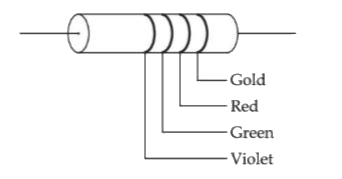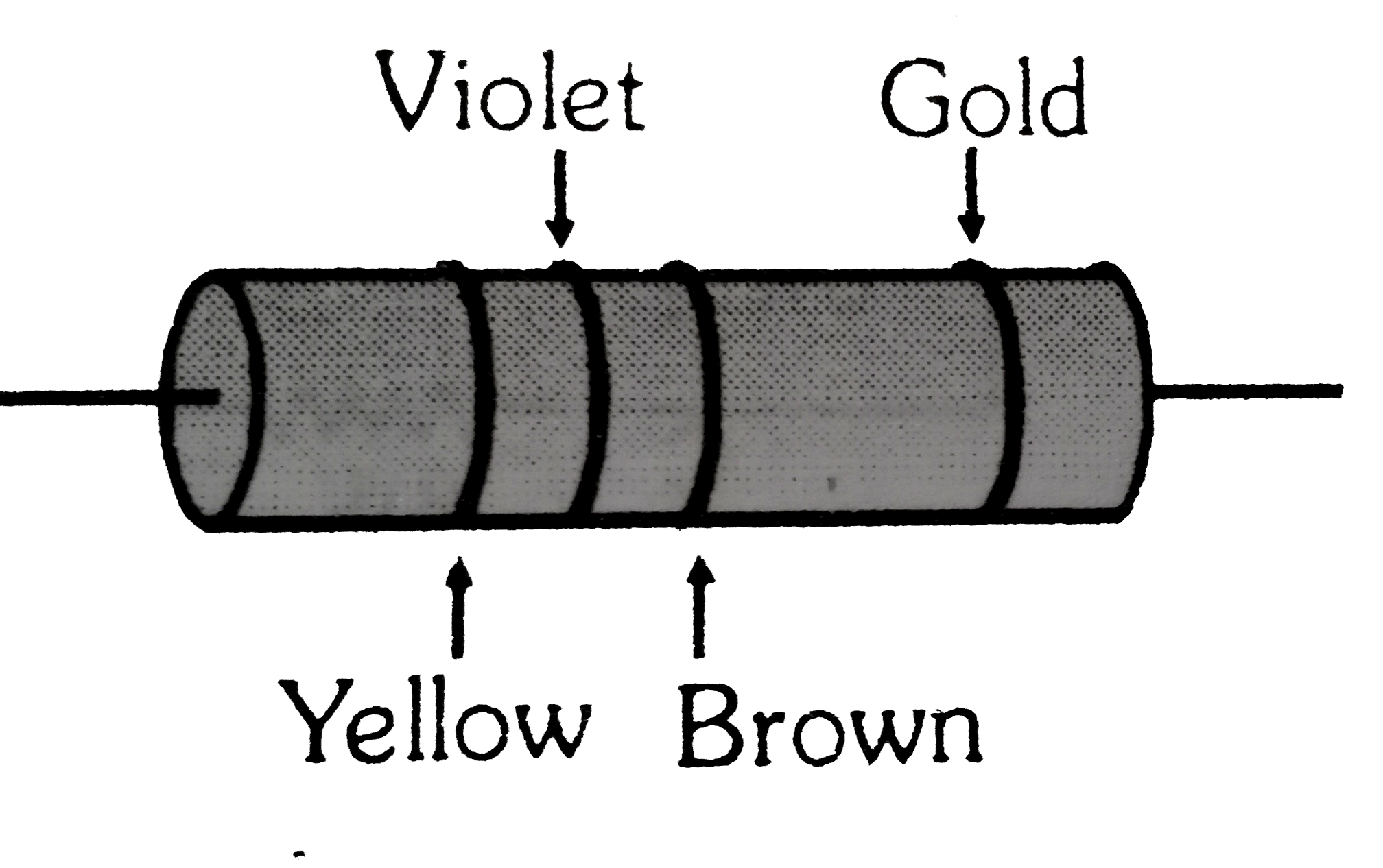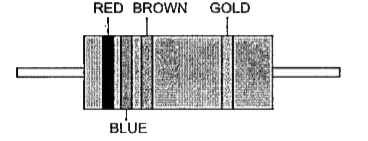Read the following text and answer the following questions on the basis of the same:
Types of resistors Most common type of resistor is Carbon Composition Resistors. Carbon resistors are a cheap, general purpose resistor used in electrical and electronic circuits. Their resistive element is manufactured from a mixture of finely ground carbon dust or graphite and a non-conducting ceramic powder to bind it all together.
The ratio of carbon dust to ceramic (conductor to insulator) determines the resistive value of the resistor. Higher the ratio of carbon, lower the overall resistance.
Film Type Resistors consist of Metal Film, Carbon Film and Metal Oxide Film Such resistors are generally made by depositing pure metals, such as nickel, or an oxide film, such as tin-oxide, on an insulating ceramic rod or substrate.
The resistive value of the resistor is controlled by increasing the desired thickness of the deposited film giving them the names of either "thick-film resistors" or "thin-film resistors".
Film type resistors can achieve much higher ohmic value compared to other types.
Another type of resistor, called a Wirewound Resistor, is made by winding a thin metal alloy wire (Nichrome) or similar wire on an insulating ceramic former in the form of a spiral helix.
These types of resistors are generally only available in very low ohmic value with high precision.
They are able to handle much higher electrical currents than other resistors of the same ohmic value with much excessive power ratings. These high power resistors are moulded into an aluminium heat sink body with fins attached to increase their overall surface area to promote heat loss and cooling.
Wire wound resistors are available in very _____ ohmic high precision values with ______ power rating.
High, high
Low, low
High, Low
Low, high
The correct Answer is:D
Wirewound Resistors are generally only available in very low ohmic high precision values. They are able to handle much higher electrical currents than other resistors of the same ohmic value with muchexcessive power ratings. These high power resistors are moulded into an aluminium heat sink body with fins attached to increase their overall surface area to promote heat loss and cooling.
Similar Questions
Knowledge Check
Read the following text and answer the following questions on the basis of the same:
Types of resistors Most common type of resistor is Carbon Composition Resistors. Carbon resistors are a cheap, general purpose resistor used in electrical and electronic circuits. Their resistive element is manufactured from a mixture of finely ground carbon dust or graphite and a non-conducting ceramic powder to bind it all together.
The ratio of carbon dust to ceramic (conductor to insulator) determines the resistive value of the resistor. Higher the ratio of carbon, lower the overall resistance.
Film Type Resistors consist of Metal Film, Carbon Film and Metal Oxide Film Such resistors are generally made by depositing pure metals, such as nickel, or an oxide film, such as tin-oxide, on an insulating ceramic rod or substrate.
The resistive value of the resistor is controlled by increasing the desired thickness of the deposited film giving them the names of either "thick-film resistors" or "thin-film resistors".
Film type resistors can achieve much higher ohmic value compared to other types.
Another type of resistor, called a Wirewound Resistor, is made by winding a thin metal alloy wire (Nichrome) or similar wire on an insulating ceramic former in the form of a spiral helix.
These types of resistors are generally only available in very low ohmic value with high precision.
They are able to handle much higher electrical currents than other resistors of the same ohmic value with much excessive power ratings. These high power resistors are moulded into an aluminium heat sink body with fins attached to increase their overall surface area to promote heat loss and cooling.
Carbon composition resistors are made from a mixture ofAfinely ground metal dust and ceramic powder.Bfinely ground carbon dust or graphite and ceramic powder.Cfinely ground carbon dust or graphite and copper powderDfinely ground carbon dust or graphite.Read the following text and answer the following questions on the basis of the same:
Types of resistors Most common type of resistor is Carbon Composition Resistors. Carbon resistors are a cheap, general purpose resistor used in electrical and electronic circuits. Their resistive element is manufactured from a mixture of finely ground carbon dust or graphite and a non-conducting ceramic powder to bind it all together.
The ratio of carbon dust to ceramic (conductor to insulator) determines the resistive value of the resistor. Higher the ratio of carbon, lower the overall resistance.
Film Type Resistors consist of Metal Film, Carbon Film and Metal Oxide Film Such resistors are generally made by depositing pure metals, such as nickel, or an oxide film, such as tin-oxide, on an insulating ceramic rod or substrate.
The resistive value of the resistor is controlled by increasing the desired thickness of the deposited film giving them the names of either "thick-film resistors" or "thin-film resistors".
Film type resistors can achieve much higher ohmic value compared to other types.
Another type of resistor, called a Wirewound Resistor, is made by winding a thin metal alloy wire (Nichrome) or similar wire on an insulating ceramic former in the form of a spiral helix.
These types of resistors are generally only available in very low ohmic value with high precision.
They are able to handle much higher electrical currents than other resistors of the same ohmic value with much excessive power ratings. These high power resistors are moulded into an aluminium heat sink body with fins attached to increase their overall surface area to promote heat loss and cooling.
In carbon composition resistors, ______ the ratio of carbon, _______ the overall resistance.AHigher, lowerBLower, higherCLower, lowerDHigher, higherRead the following text and answer the following questions on the basis of the same:
Types of resistors Most common type of resistor is Carbon Composition Resistors. Carbon resistors are a cheap, general purpose resistor used in electrical and electronic circuits. Their resistive element is manufactured from a mixture of finely ground carbon dust or graphite and a non-conducting ceramic powder to bind it all together.
The ratio of carbon dust to ceramic (conductor to insulator) determines the resistive value of the resistor. Higher the ratio of carbon, lower the overall resistance.
Film Type Resistors consist of Metal Film, Carbon Film and Metal Oxide Film Such resistors are generally made by depositing pure metals, such as nickel, or an oxide film, such as tin-oxide, on an insulating ceramic rod or substrate.
The resistive value of the resistor is controlled by increasing the desired thickness of the deposited film giving them the names of either "thick-film resistors" or "thin-film resistors".
Film type resistors can achieve much higher ohmic value compared to other types.
Another type of resistor, called a Wirewound Resistor, is made by winding a thin metal alloy wire (Nichrome) or similar wire on an insulating ceramic former in the form of a spiral helix.
These types of resistors are generally only available in very low ohmic value with high precision.
They are able to handle much higher electrical currents than other resistors of the same ohmic value with much excessive power ratings. These high power resistors are moulded into an aluminium heat sink body with fins attached to increase their overall surface area to promote heat loss and cooling.
Metal Film Type Resistors are generally made by depositing pure______, on ______ rod or substrate.ACeramic, metalBCarbon, ceramicCMetal, ceramicDCarbon, metal
The colour coding on a carbon resistor is shown in the given figure. The resistance value of the given resistor is :

View SolutionWhat is resistance of following resistor.

View SolutionWhat is resistance of following resistor.

View SolutionRead the following text and answer the following questions on the basis of the same:
Types of resistors Most common type of resistor is Carbon Composition Resistors. Carbon resistors are a cheap, general purpose resistor used in electrical and electronic circuits. Their resistive element is manufactured from a mixture of finely ground carbon dust or graphite and a non-conducting ceramic powder to bind it all together.
The ratio of carbon dust to ceramic (conductor to insulator) determines the resistive value of the resistor. Higher the ratio of carbon, lower the overall resistance.
Film Type Resistors consist of Metal Film, Carbon Film and Metal Oxide Film Such resistors are generally made by depositing pure metals, such as nickel, or an oxide film, such as tin-oxide, on an insulating ceramic rod or substrate.
The resistive value of the resistor is controlled by increasing the desired thickness of the deposited film giving them the names of either "thick-film resistors" or "thin-film resistors".
Film type resistors can achieve much higher ohmic value compared to other types.
Another type of resistor, called a Wirewound Resistor, is made by winding a thin metal alloy wire (Nichrome) or similar wire on an insulating ceramic former in the form of a spiral helix.
These types of resistors are generally only available in very low ohmic value with high precision.
They are able to handle much higher electrical currents than other resistors of the same ohmic value with much excessive power ratings. These high power resistors are moulded into an aluminium heat sink body with fins attached to increase their overall surface area to promote heat loss and cooling.
Wirewound Resistors are made by winding a thin ______ or similar wire on an _______ former in the form of a spiral helix.
View SolutionA carbon resistor has coloured bands as shown in figure below. The resistance of the resistor is :

View Solution
